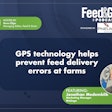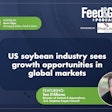
Steven Kilger, the managing editor for Feed & Grain, interviews Kurt Shultz, senior director of Global Strategies at U.S. Grains Council, in the Feed & Grain Podcast.
The interview covers two new initiatives by USGC, which include a handbook on high-protein corn co-products produced in the U.S. ethanol industry and new studies on the value of U.S. corn over its competitors.
The new handbook aims to educate international buyers about high protein DDGs and the value they create in feed ration by lowering the costs of feed ingredients and diversifying the product mix.
Steven Kilger (0:00)
Hi, everyone, welcome to the Feed & Grain Podcast. And thank you for listening. My name is Steven Kilger, managing editor for Feed & Grain and your host. We have a great show for you today. Kurt Shultz, senior director of Global Strategies at U.S. Grains Council stopped by to talk about two new initiatives the council has going on.
A new handbook with information on the new variety of high protein DDGs popping up on the market. And then we talk about a few new studies on the value of U.S. corn over its competitors. But before we get going on that, if you're listening to the podcast and a podcasting app, please consider subscribing in or leaving a rating or review. It would help us out a lot. Thank you so much for listening onto our conversation with Kurt.
Kilger (0:42)
Well, hi, Kurt. Thanks for talking to me today.
Kurt Shultz (0:44)
Yes, it's good to see you again. Steve.
Kilger (0:47)
Good to see you, too. It's been a few months. It's always nice to have you as a guest. Hopefully, you'll be back many more times.
Schultz (0:53)
Well, that's the hope. That's a hope. As long as we have something interesting to pass along. I happy to be on the show.
Kilger (0:59)
Speaking of industry, you guys just released a new handbook on high-protein corn co-products produced in the U.S. ethanol industry. I think mainly what we would call DDGs. Can you talk a little bit about what motivated you to release that handbook? And tell us a little bit about the handbook itself?
Schultz (1:16)
Yeah, let me step back a little bit. The U.S. Grains Council represents the U.S. corn industry but focused primarily in our international audience. So we are the marketing arm for the U.S. industry, representing farm growers across the United States. And so we've been active since 1960. However, probably around 2003, 2004, we became involved in educating international buyers about a new product called distillers grains, DDGs. And that was a relatively new product back in 2000, in early 2000s, for the U.S. industry, but also for international customers. We spent a lot of time in the last 20 years, really promoting the product, but also educating nutritionists for dairy, swine, poultry, even aquaculture, about the value of DDGs and feed ration.
Schultz (2:12)
It competes with other raw materials, but really the value that it creates is, in certain opportunities, allows them to lower the costs of their feed ingredients, and also diversify their product mix. So you spread your risk about across different products. That was the early phase of our education program. We saw DDG exports really go from zero tons to now we're at about 11 to 12 million metric tons of DDG exports going to over 50 countries worldwide. That's really driven by this education effort that the council does through its consultants and staff that are working overseas.
Schultz (2:51)
So newer evolution has come to the industry. The ethanol industry is now looking at producing higher value products, the technology has changed that allows them to further ferment or concentrate distillers grains into products that have even higher and very different values. DDGs in general was kind of lumped into a standard product in the past. Now they're coming out with what we would call high protein DDGs. Corn fermented proteins, there's a variety of different names. But essentially, the protein value of the DDGs has almost doubled, if not, in some cases quite a bit higher. So with that increase in protein level, it changes how this corn fermented protein product is being utilized.
Schultz (3:42)
Our new booklet is really intended to adapt to the changes that we're seeing in the industry, and to, not only educate ourselves and our staff, who then have to take that message out and talk to our customers internationally. And each company that markets this is going to have a slightly different product. So there may be five to 10 different varieties of products based on whether they have you know the protein levels or whether they add yeast to the product that has certain nutritional profiles, that changes the product mix.
That booklet that we just released is really an our first attempt to start to dive into this space and start to build excitement about a new product when how to use it in these different animal species.
Kilger (4:28)
Yeah, I've seen that news, it's a pretty expensive piece of technology, but ethanol plants are investing in it. And I saw even on the last couple of years, a few more came out, which seems to be a bit of a game changer. Let's talk about DDGs.
Schultz (4:42)
Early in the industry, DDGs were seen as a byproduct and they're really focused their financial profitability on the ethanol side of things and now I think you see DDGs and the co-products being just as important and the profit portfolio these ethanol companies and so it is evolving very quickly and it's more efficient the energy value more of it's being converted into ethanol. So these plants are increasing their efficiency. These new products have a new market opportunity, which is, a lot of them are in aquaculture will use a higher protein product similar to soybean meal. And you also see that going into poultry and layer rations.
Schultz (5:24)
jUst understanding how these products fit and then, and certainly the companies internationally as they start to buy them, they can talk to their supplier and get even more specifics about recommendations. But it's really an education to show this evolution. We have already seen exports into Mexico and even in West Africa. We did an initial project there, and we've already been able to sell some of this corn fermented protein into West Africa and containers. And certainly Southeast Asia and Asian markets are really excited by this. It is something that I think we'll see more and more interest as years go forward.
Kilger (6:03)
Anything we can do to get more value out of the product right and increase our own sustainability footprint for the industry as a whole is always good. So what information does the high protein handbook have in it for both foreign buyers, and also, maybe even people in the domestic market might be interested in kind of looking at?
Schultz (6:24)
One, I would just say that a handbook is on our website at grains.org and broad brushes to describe it as there's a overview of the different types of products that are being produced, certainly not comprehensive, I would just say it is of primary products that we're seeing in the market. Then it goes through the advantages or the characteristics of each of them, and I think the bulk of the book focuses on the different animal species so that poultry, swine, cattle aquaculture, what would be the ways to use these products at what levels and how does that mix in and replace other ingredients.
Schultz (7:03)
What's not there and ultimately is up to the nutritionist is that there's a feed formulation where they put in the cost of the ingredients and their nutritional characteristics. And then that system makes recommendations based on price and nutritional profile. So it's really just a guide for the end user, depending on the species that they're looking at. For the domestic audience. It's very similar information, and the utilization is very similar. It's just certainly of U.S. grains for the domestic audience. USGC makes it available to any audience that's interested in looking at it, but our focus is primarily to be able to provide that resource to international buyers that are meeting with exporters and trying to get a better handle on what kind of products are out there.
Kilger (7:50)
That's great. Is there information on other corn coproducts in the book? Or does it strictly focus on DDGs
Schultz (7:57)
It's strictly on DDGs. We have other handbooks up there. An older version of the DDGs that were 23% protein, the earlier versions are up there. Then we certainly have information on corn gluten feed and corn gluten meal and other guidebooks. But this is specific to the new evolution of distillers grains that's out there.
Kilger (8:19)
Yeah, well, it's a great note, though, that let people know that there's actually a wealth of information you guys have on your site for all kinds of products. I also hear that you guys are doing some research into U.S. corn profitability versus some foreign suppliers. Can you go a little more details into that?
Schultz (8:36)
There's two aspects to this study. And it really came down to trying to differentiate U.S. corn against corn from other suppliers. One of the complaints, I guess, has been that the U.S. corn tends to be a little bit older because we store it. And we have a much longer export system where the grain could start up in the upper Mississippi and be handled several times as it comes down the Mississippi River and that is loaded into vessels and dropped from heights. There tends to be a little bit more stress cracks and broken material and the corn. For years, we've been trying to figure out how to address that because for the foreign customer, they always will look and say well, yes, U.S. corn tends to be more dusty than Argentinian and Brazilian and it was more of a visual aspect. There are other issues that have to deal with handling and and storage of the grain.
Schultz (9:29)
My question has always been well, how does it perform? Because ultimately, you're going to grind that grain and put it into chicken or swine feed and you're going to pelletize it. So there is some broken corn but it's essentially a starch product that's in the grain. With that kind of background. We started a project and it's on two aspects. The first one was we looked at it for the industrial starch industry, which is a very large industry. It produces some of the food starches that we use it but there's a lot of chemicals produced are used in the pharmaceutical and other industries. It's a very sophisticated industry. It's similar to a chemistry project where you add corn into a steeping tank and you extract the different aspects of the corn and what you put in, you get out in some other form.
Schultz (10:19)
We reimported corn samples from the United States, but they were out from our customers overseas, we went to the plants in Egypt, in Korea and Colombia. And we sent U.S. corn, Argentinian corn, Brazilian corn, Ukrainian, and even Indian corn from the warehouses of our customers to the United States and have them analyzed. So essentially, they were taking corn that they had received and said, let's see how those yields of those different varieties perform. And we've done two years of studies. And we're in the middle of our third year of this study at the University of Illinois. And the results have come back that US corn yields 3% to 4% higher yields of available starch than other origins.
That has to do with U.S. corn being softer, it's less bound up in a protein matrix. As a result, these plants can increase their profitability significantly by using solely U.S. corn. And just use an example a starch plant that uses about 1,000 tons of corn a day, which is my understanding is about a midsize plant, for every percent of yield increase in starch 1% yields to a million dollars per year of additional profitability. So if you're getting 3% yield increase, you're getting $3 million additional profit if you were just to use 100%, U.S. corn.
Schultz (11:43)
This has really a significant impact because there are probably 40, some plants internationally, starch plants, not all of them are able to import U.S. corn because they could be in the middle of a landmass where it's hard to get access to U.S. corn, but of those that couldn't get access to it, they could increase their profitability simply by using U.S. corn over other origins.
Schultz (12:06)
The second aspect that really is exciting and even more significant is that there's initial processing time that it's called steeping. You have to stick the corn in a water bath, so to speak with some chemicals to kind of break it apart, similar to cooking. And in that process, U.S. corn steeps, only 24 hours versus you need 48 hours for Argentinian, Brazilian or Ukrainian. Once you get through that first phase, you can double the throughput through your plant of using U.S. corn because you don't have to be locked up in that initial phase with a lot of space occupied with a second day of steeping of the corn. We're really excited about this. We're actually having a conference next week in Korea with a global starch industry and presented these results. Really, the goal is to get them to start to buy and prefer U.S. corn over other origins. That is one area that's really exciting.
The second one, so we thought well, if it does that in industrial side, is it possible to do it in the feed side. We actually went to a feed miller in Colombia feed plant and got five tons of us Argentinian and Brazilian corn and re-exported it back to the United States. We milled the corn from each of these origins and then fed them in swine and poultry rations. We've done the first year the study, we got the results we're doing a second year, because you always want to try to take out that variability of crops change based on the productivity conditions and things like that.
The first year of data, U.S and Brazilian corn were equal. And I'm going to focus on the poultry aspects of it because results on the swine were pretty much the same also. But where we find the interesting results around the poultry side. U.S. and Brazilian corn are relatively equal in feed conversion rates for chicken. But in U.S. and Argentinian, we found that U.S., the feed conversion rate, which is really how much feed do you need to feed the chicken to get one kilo of growth was higher for U.S. corn, I'm sorry, it was lower. So a lower feed conversion rate means you get faster growth at a lower volume of feed.
So we had a lower feed conversion rate. And you know, it's a small number, it's the the hundreds, like it's 1.402, something like that. But we had enough, when you put that into a commercial operation. If you look at a culture operation that produces over a million birds a week and so this is a large company on the scale of Tyson or some of these other large poultry producers, if they feed 100% U.S. corn versus Argentinian at the end of the year they'll have over $400,000 of additional profitability because essentially what they're doing is each individual bird is a small amount but when you add up a small amount of growth across a lot of birds, it translates into real financial savings.
And so we're doing a second study this year, as I mentioned earlier the Auburn University poultry study; this one is with South Dakota State University a swine study. Again, the idea along with the starch study is that that starch is in the corn kernel is the same for each origin, but it's easier to digest in the U.S. corn -- and that's what's important in an animal diet is protein, and energy. If you can get those two components, easily digestible, and they don't go out as waste products, then the animal gets the maximum benefit from that, and the farmer or the producer gets the other more productive animal. So those are really focusing on financial benefits of using U.S. corn so that we can go out and, and talk about that and really promote the U.S. origin over other origins when we talk to our buyers internationally.
Kilger (15:58)
Yeah, that's what I love about the U.S. Grains Council, you guys are always doing such fascinating things. And really, you're doing it for our industry, which is really important work that we're always happy to have you on here to talk about.
Schultz (16:11)
And ultimately, the goal of USGC, we're an organization, we represent individual farmers, in essence, from Minnesota, from Iowa, from Illinois, Nebraska. They're members, they sit on our advisory boards, and our goal at the end of the day is, not to make buyers look at the U.S. and say oh, we'll just buy when we need corn from the U.S, if it's available. We want them to go and ask for it and a preference rather than just say, "give me what you have." No, I want you to send me U.S. because we see this increased profitability.
Our next steps on all of this, we're doing commercial trials in starch. Now we're taking it from the university level, back out to the field, it's next year and doing commercial trials with industrial starch plants, we have three lined up right now around the world that are willing to work with us on this and to really show that data and that faster steeping times. And we're going to do the similar thing with the feed industry, to go to a international customers and basically do trials that show that these animals grow faster and get faster weight gain using U.S. corn versus other origins. Then that translates, you know, when you start talking money, and talking, what does this mean for your profitability, it gets people's attention very quickly. If you say buy U.S. corn, because we're good guys. That's okay. That gives you a nice nod and a smile but but when you show what it means to their pocketbook, you get believers very quickly.
Kilger (17:41)
You'll have to come back and tell us how those studies go. For some other information on what you guys have going on. It's one of my favorite reoccurring columns in the magazine. I think everyone should look at it. Every two months, you guys go through and you what you're doing across the world to promote U.S. grains. It's one of my favorite things to read, because it's real world examples of what you're doing out there. So thank you again, so much for coming to talk to me.
Schultz (18:04)
Thank you for your time. And I would just say that you're mentioning reading the column and what we do, but a lot of what we do is take the lessons that we learned in the U.S. and take them out overseas. And so we really start at the grassroots. The research that we've invested in universities and our professional people become consultants for us. So the U.S. industry is strong and has a very practical knowledge base. A fun part of my job is I'm just taking experts and introducing them to other people and letting them do the teaching.
Kilger (18:35)
You guys do so much teaching and that's a big part of what you're doing. Once again, thank you so much for talking to me. Everyone out there, thank you so much for listening, and I hope you stay safe out there.
Schultz (18:46)
Thanks. All right, goodbye.
.jpg?auto=format%2Ccompress&crop=faces&fit=crop&h=48&q=70&w=48)


















